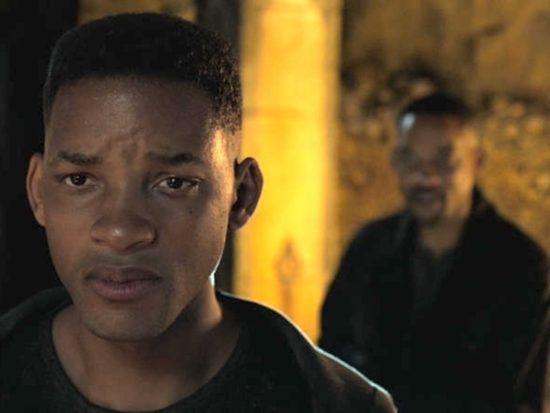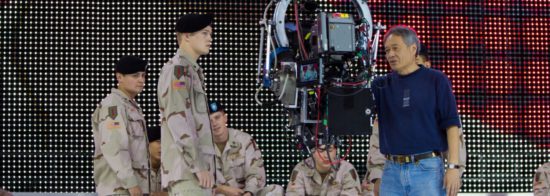Gemini Man might be a great 3D movie only half the world can see.
The International Broadcast Conference (IBC) in Amsterdam is about what to see and how to see it and much of what we ran into was cinema: new cinema, big cinema, and great big screens for the small screen, i.e., TV.

Ang Lee’s Gemini Man is making its way to world theaters in October. It represents the director’s single-handed attempt (with the help of millions of dollars, a crew of experts, and Will Smith) to save 3D. Lee believes that 3D has not been successful in theaters because the quality has not been good enough. Movies may be too dark and the 3D effect is an afterthought. He insists frame rates go up to accomodate two projects and show off 3D at its best. He may be right, early reviews from press screenings of Gemini Man are very positive and they stress the visual experience and especially the immersive effect Lee was able to achieve.
Gemini Man was shot in 120 fps in 3D and at 4K resolution. However, it will be screened using different resolutions and frame rates depending on the capabilities of the theaters.
Interest in 3D movies has waned in the west, but the fervor for it is still strong in Asia. However, most movies today are not shot with 3D cameras—the overhead has been deemed not worth it, given the ability to create good-enough 3D from high-quality cameras.
It’s hard to imagine telling Ang Lee to accept “good enough,” and that extends to the camera. Lee famously pushed the limits on Life of Pi. Lee embraces 3D shooting as an advantage that has never been fully realized because of the drawbacks of standard 24 fps cinematography.
Lee also shot Billy Lynn’s Long Halftime Walk in 120 fps and 3D. The movie did not do well, but Lee has said that he has come out of the experience more convinced than ever about the value of HFR. Reviewers do agree that the use of HFR gave the film’s most intense scenes an intimacy and sense that the viewer is right there with the characters.
Lee’s cinematographer Dion Beebe used Arri Alexa 3.2K cameras modified to shoot 120 fps on a Stereotec 3D rig and the output was upscaled to 4K.
The camera has its own requirements. Shooting with 3D camera rigs means the camera is in charge of the action in some ways. It’s huge. Lee refers to it as being like moving a refrigerator. 3D encourages viewers to take in a scene. Fast camera moves can be uncomfortable for viewers and motion blur occurs at slower frame rates. Luckily, Lee loves giving audiences a full scene and time to look at it.
In addition, shooting in 120 fps places demands its own demands, especially for an action film. There’s no motion blur to connote action, there is only action. In 3D, Lee observes, it can feel like the actors and the action are in the viewers’ space, not safely enclosed within the screen window. Also, close-ups, which Lee did not shy away from on Billy Lynn, read more in faces than actors might intend and make up has to be done differently in case it becomes too obvious. Reviewers of Billy Lynn have noted that the acting seemed overdone in some cases and ironically the less experienced actors came across better. Talking about the action scenes in Gemini Man, Lee says they have to film action scenes as realistically as possible, an article in SyFyWire says Lee refers to the style as “messy fighting.”

Working in the future
Lee acknowledges that his decision to film in 3D and at 120 fps means that a large proportion of the audience will not see the movie as he intended, in 3D, 120 fps, at 4K with immersive audio. Billy Lynn was screened in 3D, 120 fps, in exactly two theaters in the U.S., The ArcLight theater in Hollywood and AMC Lincoln Square in New York. Currently, Christie makes the projectors which were used to screen Billy Lynn using the company’s laser projection technology.
In the Future of Cinema panel at IBC, Susie Biersdorf, Christie’s vice president of sales for North America, says that there’s not a lot of appetite among theater owners to do further upgrades for 3D and HFR at the moment. She says, they’re putting in stadium seating, better quality food, and drinks to improve the theater expensive and that’s working for them. A situation that clearly disappoints her.
Biersdorf also talked about the innovation going on in China and Korea and says that it will change how movies are made and watched. She mentioned Cinity Cinema, which distributors Huaxia debuted at the end of August in Beijing. Cinity is the result of a collaboration between Christie Digital Systems, and GDC Technology, a Hong Kong-based company which develops cinema automation systems, enterprise software CMS and NOC, and digital cinema servers. Together, the companies have developed the projection system. The first systems are installed in cinemas across Mainland China, Hong Kong, Macao, and Taiwan, with more to come. At CinemaCon in Las Vegas last April, Huaxia committed to 100 screens in time for Gemini Man’s worldwide opening in October. Otherwise, Paramount is ready to show the movie in the best formats available. According to ScreenDaily, Paramount will distribute the movie in several versions including 2D, 24 fps, or 3D, 2K, 60 fps.
Ang Lee is doing his part tirelessly preaching the virtues of 120 fps. Lee bemoaned some of the negative artifacts that accompany stereoscopic 3D, which he felt all but ruined Life of Pi. He described problems with strobing effects, motion blur, and dim lighting. The movie’s editor Jim Squyers spoke at IBC about HFR technology. Lee, he said, “fell in love with 3D on Pi but also recognized the difficulty of shooting 3D at 24 frames a second. Squyers said that tests shots made for a possible film about Joe Frazier and Muhammed Ali revealed that many of the problems they saw for Life of Pi could be solved by shooting at a higher frame rate.
Squyers edited the movie using Avid in 3D. He said, I always cut in 3D because when you are making a 3D picture you make different decisions than you would in 2D. Instead of imagining what the 3D would be like, I’d rather work in it from the start. He said that the Avid setup supported 4K but he did his editing in standard definition because of the performance benefit. He also viewed and cut it at 60 fps aided by RealD’s TrueMotion technology, which smooths the frames together and hides the effect of going to 60 fps from 120 fps. The result, he says, is a 60-fps movie that looks better than if it had been shot in 60 fps. In addition, TrueMotion enables the movie to be output in different frame rates from the 120 master. For Cinity, it will be shown in 240 fps, 120 fps per eye.
Coming to a theater near you?
Attendees at the Cinity debut included Hollywood Disney, Paramount Pictures, Warner Bros Movies, Sony Pictures, and Legendary East. They, very likely, would like to get the little goose for tickets prices that will accompany 3D HFR. James Cameron and Douglas Trumbull have pledged support for Huaxia Cinity. Avatar isn’t coming for another couple of years yet, but it looks like it will have theaters ready and waiting for it in 3D HFR.
IMAX is in the process of upgrading its most popular theaters. A deal with Cineworld will add IMAX laser technology and 12-channel immersive sound along with plush rocker seating and new entryways in 15 Regal theaters in the US. In April, the company announced a deal for laser projection in 87 AMC IMAX locations.
It should be said that, even if there will be relatively few 3D, 120 fps screenings, 3D 60 fps is going to be an experience for audiences. Right now, theaters are talking about the films in the theaters now Ad Astra, Downton Abby, and The Joker so there’s not much information on what formats the theaters will use for Gemini Man.
What do we think?
Ang Lee has said he doesn’t see the need for VR because “my VR is better…” I believe him. I have believed that high resolution, and now high frame rates can immerse the audience. I have had to be convinced about HFR, but after a rocky start with Peter Jackson’s Desolation of Smaug in the first few minutes, I stopped noticing. (You know, it really wasn’t that good of a movie.) And Ang Lee may also convince me on the stereoscopic 3D for the movies. I like it in general, but there are many 3D films that are disappointing because there is not a real sense of depth, rather, stacked planes. And again, a bad movie is not any better in 3D. Sometimes it’s worse.
There are a lot of fingers being crossed for this film. If it’s a hit, it could transform moviemaking overnight. If not, it might take a little longer.





